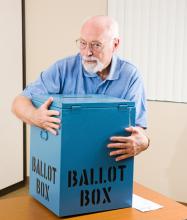Commentary
ONE OF THE best things about growing up in the 1970s was Schoolhouse Rock! on Saturday morning TV. The day my high school history class began to study the preamble of the U.S. Constitution, we all broke into song: “We the People ... in Order to form a more perfect Union, establish Justice, insure domestic Tranquility, provide for the common defense, promote the general Welfare ...”
In the ’70s, Americans still believed those words; the general welfare was important to policymakers across the political spectrum. Today, we have a political discourse where the Republican presidential contender disparages the elderly and the unemployed for collecting benefits for which they’d paid into an insurance fund.
And now policymakers are allowing the looming “fiscal cliff” to threaten the U.S. economic recovery from the recent recession. At the end of this year (or a few months later if Congress kicks the can down the road), Congress and the administration must work out a compromise on spending cuts and revenue increases, or the economy will face deep, mandatory federal spending cuts and across-the-board tax hikes. Such deep spending cuts would devastate many programs that aid those most in need. And, in addition to hurting families, spending cuts at this point in the recovery threaten to derail economic growth and job creation.
In order to make sure fewer people need unemployment insurance benefits, Congress needs to run deficits for the next couple years. Economists are in general agreement that what the economy needs now is more fiscal expansion—that is, an agenda that will make investments that could create jobs and pave the way for long-term economic growth. Federal Reserve Chair Ben Bernanke pointed this out in a recent speech: “Fiscal policy, at both the federal and state and local levels, has become an important headwind for the pace of economic growth.”

THE TASTE OF the election still may be in our mouths—but Advent is breaking in.
Advent is a four-week stomp to Christmas. It is the time when God starts to show. God is pregnant during Advent: pregnant with possibilities that somehow, some way, someday, things will be different. They will taste better. We will know their taste better. We will be able to be engaged in our lives and our commitments and also be at peace. We will be the ones at the birthside, marveling about how God could dare come as a child or send heaven to earth, spirit to flesh, drenching humanity with divinity. The big words for this showing will be “Son of God” and “joy to the world.” The angels will sing, the night will go silent, the people will hark.
This Christmas would be a great time to notice what we have already seen: that when leaders and things get too large, when we put too much trust or hope in them, they revert to a brutal and brutalizing smallness. When we put trust in what we can notice, what we can do and who we can be, we are rarely disappointed. We expect, expectantly, as though we too were pregnant, day by day, with the possible.
For now, there is the waiting, the preparing for an Advent practice that will smell and taste good, that will open doors on more than a calendar.
I am an avid reader of women’s magazines, especially those that have a centerfold of the perfect Christmas dinner. I praise that dinner, hope for it, plan for it, and then eat with vigor what really comes out. A friend has a sign on her refrigerator about the difference between what we usually have and what the magazine announced: “It’s not going to happen that way.” By that sign, she is preparing herself for a day and a life of surprises. She is grooming her “to don’t” list.

A TRADITIONAL whale-oil lamp is solemnly lit by an Inuit elder. After being brushed with cedar and smudged with sage, three commissioners take their seats. A survivor begins his testimony, haltingly narrating painful memories from 60 years ago. Soon tears begin to flow, and a support person carefully collects the tear-soaked tissues into a basket, to be added to the sacred fire that burns outside the hall. In this space, so filled with sorrow and rage, every ritual communicates respect, empathy, and determination, turning public halls into sanctuaries of healing.
For seven generations Indigenous Canadian children were taken from their homes and sent, most often by force, to Indian Residential Schools. Churches began operating these schools in the early 1860s, and by the 1890s the federal government had begun to make attendance mandatory as part of a policy of assimilation into Canadian society. In these schools children were forbidden to speak their native languages, forced to conform to European ways of life, and often abused emotionally, physically, and sexually. Though most residential schools were closed by the mid-1970s , the last was not shuttered until 1996.
As part of a 2007 legal settlement with survivors, the Truth and Reconciliation Commission of Canada (TRC) was created, with a five-year mandate to document the testimony of survivors, families, and communities affected by the residential school experience and to inform all Canadians about this tragic history. Launched in Winnipeg in June 2010, the TRC will include seven national and a number of regional hearings throughout the country. The hope is to “guide and inspire Aboriginal peoples and Canadians in a process of reconciliation and renewed relationships that are based on mutual understanding and respect.”

EVEN AS ELECTION-YEAR news cycles move on, the nation faces the aftermath of a prolonged and dramatic heat wave. July 2012 broke two records: It was the both the warmest July ever recorded and the warmest month—period—ever recorded in the lower 48 states. In our home of Chicago, temperatures crept past 100 five times. Moreover, the extreme drought of 2012 is not a random event, but part of a worrisome trend.
Global climate change has come to the heartland. Unless we take collective and decisive action, 102 could become the new 93. And it’s not just armpits and foreheads that will sweat. We have already glimpsed the future, and it is not pretty: massive forests burned in Colorado; major power outages; thousands of acres of crops lost to drought in Illinois, Indiana, Kansas, Missouri, Oklahoma, and elsewhere. These ominous events are indications of the “new normal” unless we make widespread changes in fossil-fuel consumption.
The farming crisis has been acutely severe—and it is directly related to climate change. This summer, the U.S. Department of Agriculture designated more than half of all U.S. counties as disaster areas (1,584 in 32 states). Fred Below, a crop biologist at the University of Illinois at Urbana-Champaign, bluntly summed up the reality: “It’s like farming in hell.”
Ironically, agriculture is the human activity that emits more greenhouse gases into the atmosphere than any other source, including transportation and industry. A key reason: Today’s agriculture intensively depends on burning fossil carbons. (Methane emission from cows and rice fields, and deforestation to clear farmland in the global South, are also contributors.) Being so dependent on fossil fuels means that the food sector is the greatest contributor to global climate change—and that rising oil costs increase food costs, squeezing the poor and marginalized.

IN THE TRAGIC, often-hopeless world of gang violence, this year’s truce between two notorious gangs in El Salvador offers reasons for hope and a breakthrough opportunity for change.
Beginning in March, leaders of the infamous gangs Mara Salvatrucha (MS-13) and Barrio 18 called a truce from behind prison walls. The agreement was mediated by Monsignor Fabio Colindres, the Catholic chaplain for the Salvadoran police and military, and Raúl Mijango, a former legislator and, before that, military commander in the FMLN, the onetime guerrilla movement that is now the country’s elected ruling party.
The truce, which was still in effect at press time, immediately reduced violence in El Salvador, which has been among the world’s most deadly countries in recent years. Since early April, said President Mauricio Funes in late August, the murder rate has gone down to around five per day, a decrease of more than 60 percent from the 13.5 per day average of January and February.
The gang violence that has plagued El Salvador and other Central American countries in recent years is an import, brought by youth deported from the United States. MS-13 and Barrio 18 both originated on the streets of Los Angeles—ironically, built by young people whose families were refugees fleeing the U.S.-backed violence of Central American civil wars and death squads in the 1980s.
But just as violence can be moved across national borders, peace can be as well.
WHEN AMBASSADOR Chris Stevens and other embassy staff were killed in Benghazi in September, it struck close to home for us at Sojourners. The last time a U.S. ambassador was slain was in 1979, when Adolph Dubs, the American ambassador to Afghanistan, was kidnapped by Islamic extremists and later killed. His daughter, Lindsay Dubs, was Sojourners’ managing editor. The degrees of separation between world events and the home front are often slim.
Some attributed last month’s violence in the Middle East to “fanaticism,” a “blind and tragic barbarism” by “imbeciles.” Others used words such as “beyond pathetic,” “fringe,” and “extremists.”
Those descriptions were applied to both those who created the anti-Islam video that provided the spark, and those who used the hateful video as a reason, or excuse, to engage in violent protests against the United States and the “West,” including Israel.
The media repeatedly summarized the cause of the violence as resting in the intentionally offensive video, and said that Muslims, angered by the blasphemous depiction of the Prophet Muhammad, rioted in a blind and uncontrollable rage. Moustafa Bayoumi, writing for the Middle East Research and Information Project, described the process: “Islamophobes provoke. Too many Muslims respond. Non-Muslims believe Muslims are crazy. Muslims are told the West hates them, and the Islamophobic right sleeps well at night with their cozy dreams of a mission accomplished.”
IN THE PAST two years, I’ve done two smart things: I went fishing last summer, and then I went fishing again this summer. Fishing is teaching me the art of waiting. And how to wait is what Mark 13:32-37 and the spirit of Advent are all about.
There is the obvious parallel: The very act of fishing, like the celebration of Advent, is a ritual of hope. Both are filled with expectation; we are waiting for something.
But some similarities are more subtle. Don’t be deceived by tranquil scenes of grandpa, fishing pole in hand, leaning against a tree, eyes closed, lazing away ... Take it from me, to be truly fishing is to be constantly on guard. You are always watchful, always mindful, always alert for the slightest touch on the line. The attention is so focused that eventually you can feel or hear a fish circling the bait. But if the concentration breaks, even for a split second, chances are you’ve missed what you were waiting for.

IN NOVEMBER, Californians will vote on a ballot initiative that would end the death penalty in the state: the Safety, Accountability, and Full Enforcement Act of 2012, known as the SAFE California Act. The backdrop of this vote is California’s deep economic crisis and the economic savings to be gained from ending capital punishment. But when the debate is largely concerned that the cost of killing criminals is just too high, where does faith come into the conversation?
If the measure passes, all 725 death penalty sentences in California will be converted to life imprisonment without the possibility of parole. The supporters of the initiative have one main mantra: “California can’t afford the death penalty!” This initiative delivers on savings—around $1 billion in the first five years, say supporters—due to halting the death penalty’s expensive legal processes and increased costs for death row detention.
The initiative also redirects some of those funds, $30 million per year for three years, to counties across the state to help investigate unsolved cases of rape and murder. In 60 percent of rapes and 36 percent of murders in California, no one is even charged with the crime, let alone convicted.
Death row prisoners are generally not allowed to work; once their sentences are changed under this initiative, they will be required to work inside the prison and to pay into California’s victim compensation fund.

COAL, NATURAL gas, petroleum. Thoughtlessly we call these substances “fuels”—fuels to burn for creating pleasant climates inside homes and offices; fuels to power appliances and engines. For years, like nearly everyone, I never thought beyond our mere use of these things. I neglected to consider their role in the Earth’s wider economy.
This all changed when my family moved to a Wisconsin peatland in 1972. Since then, conducting research there with my graduate students has produced four decades of discovery.
For thousands of years, wetland plants and algae in a bay of glacial Lake Waubesa took carbon dioxide from the atmosphere. They transformed it by photosynthesis into the carbon structure of life, eventually adding their remains, page upon page, to the accumulating peat. Eventually, this peat filled the bay for an area more than a mile long, reaching a depth of 95 feet at the present lake edge. When first I walked here, I saw the vibrant surface of plants and wetland creatures; now, in my mind’s eye, I also see the deep-layered remains of creatures below.
Also standing and walking here (much more gracefully than I) are sandhill cranes. These stately creatures, as conservationist Aldo Leopold observed, “stand, as it were, upon the sodden pages of their own history.” Elsewhere, the sodden pages of peat deposits have been cut over the ages to be dried for fuel. The early Romans saw this practiced by conquered peoples of northern and western Europe. Peat was also used as fuel in Ireland, Scotland, and northern Europe after forests were cleared for agriculture. And peat is the precursor of coal, transforming under geologic pressure into brown coal, bitumen, bituminous coal, and anthracite.
ON A WINDY morning this March, as the Supreme Court began hearing oral arguments about the health-care reform law, the Affordable Care Act (ACA), hundreds of people of faith gathered in front of the court building. As part of a public witness, they prayed and carried signs that proclaimed “People of Faith for Health Care.” Participants came from various faith traditions and denominations, many of which also signed an amicus brief in support of the ACA’s expansion of Medicaid to cover more low-income adults. The event was organized by two interfaith coalitions, Faithful Reform in Health Care and the Washington Interreligious Staff Community (WISC) Health Care Working Group.
The groups involved were motivated not by political beliefs but by a moral imperative, shared across faith traditions, to build a just society that cares for the poor, the sick, the widow, the orphan, and “the least of these.”
Those who gathered believe that their prayers on behalf of the uninsured were heard when, almost three months later to the day, the Supreme Court upheld the ACA. Chief Justice John Roberts’ vote with the more liberal justices led to the unlikely majority that provided a major step forward in the century-long struggle for health-care justice in the U.S.
Apparently you have never really understood the white man’s religion. If you had, you would not have begun your public ministry by calling for repentance. I mean, repentance is radical change, a recognition of guilt, a reversal of its past, an about-face. You can’t expect that from people.
You must have read the multitude of studies that show beyond a shadow of a doubt that no means of communication can do more than make very slight changes. But you talk about “rebirth.” What nonsense! ... You ought to focus on smaller changes that might reasonably be expected. But no. You make outrageous demands that force people to conclude that you are irresponsible.

IF YOU HAVE ever been to Jeju, you will understand why it is called a paradise. Lying in the waters south of the Korean mainland, this volcanic island is stunningly beautiful, from its clean mountain streams to its placid coral reefs. Jeju’s legendary female deep-sea divers harvest clams, abalone, and seaweed, relying on lung power alone. The island is also a spiritual place, said to be the body of Korea’s creation goddess, Mago. Jeju has been designated a UNESCO World Heritage Site and a World Biosphere Reserve.
Since January 2011, it’s also been the site where a $970 million naval base is being constructed by the South Korean government, with the help of giant construction corporations such as Samsung. The base, located in the small farming and fishing village of Gangjeong, will occupy a unique three-quarter-mile stretch of coastal wetland, threatening an ecological system that harbors several endangered species. The naval base construction also contributes to increasing military tensions in Asia, raising the risk of a devastating war in the region. Today, islanders, religious leaders, and peace activists are calling attention to dangers caused by joint U.S.-South Korean militarization.
The base is slated to be home to 20 warships, including submarines, aircraft carriers, and destroyers, several of them equipped with missile defense technology with the stated goal of protecting South Korea’s sea lanes and shielding against attack from North Korea. Civilian cruise liners will also be able to dock, according to the government. South Korean naval official Ku Okhyoe told a press conference last fall that U.S. military ships will be allowed to dock at the base only temporarily; Ku insisted, “The base is not intended for a certain country.”

THE FARM BILL has a profound impact on farming and nutrition. Three key things the multi-faceted bill provides are: a safety net for farmers, incentives for conservation practices, and food assistance for low-income families. Congress writes the farm bill every five to six years; the most recent Farm Bill, approved in 2008, expires Oct. 1.
At present, nearly 80 percent of the bill’s roughly $100 billion a year in spending goes to the food-assistance category, most notably to food stamps—the Supplemental Nutrition Assistance Program, which now helps feed 46 million people in the U.S. Less than 10 percent of current Farm Bill funding supports water and soil conservation practices, such as no-till farming and preserving wetlands and grasslands.
In the past, a significant part of the bill has been commodity payments made under various programs to farmers of crops such as corn, wheat, rice, cotton, and soybeans (but not fruits or vegetables). As farmers are currently benefiting from high grain prices, while the government faces budget deficits, the next Farm Bill seems poised to recognize that the time has come to end commodity payments.
However, farmers, challenged by volatile swings in crop prices and by uncertain weather, still need a safety net. In lieu of commodity payments, the Senate version of the Farm Bill, passed in late June, moves toward subsidizing crop insurance, which covers farmers—including fruit and vegetable growers—against both poor yields and poor prices.

TODAY, THE RIGHT to vote is under assault across the country. From photo ID requirements to restrictions on voter registration, there are new barriers to the ballot box. While proponents of recent election law changes claim those changes are “race-neutral,” the measures will have a disproportionate impact on minority voters.
In Florida, for instance, African Americans made up 32 percent of those who voted on the Sunday before Election Day 2008, often in “all souls to the polls” drives organized by historically black churches. They were among the nearly 8 million Americans who voted early. Florida, Georgia, Ohio, Tennessee, and West Virginia have since passed legislation reducing early voting.
The tea party-infused True the Vote, reportedly bankrolled by Far Right billionaires Charles and David Koch, plans to bring lawsuits to purge the voter rolls of allegedly ineligible voters. While the fear-inducing image of non-citizens voting has little to no basis in reality, it has real consequences.
In Florida, a law passed last year effectively stopped the League of Women Voters, Rock the Vote, and similar groups from conducting voter registration drives this spring. The law imposed restrictions on voter registration volunteers and subjected groups to $1,000-a-day fines if they didn’t turn in voter registration forms within 48 hours of completion. While parts of the law were temporarily blocked at the end of May by a federal judge as unconstitutionally “harsh and impractical,” it has already prevented civic groups from registering voters for some months. Registration drives encourage voting among the young and people of color, who often vote Democratic.
CHOOSING TO PAY more for a gallon of gas than the price at the pump sounds a bit crazy—but that is exactly what a couple of dozen members of the Community of St. Martin, a worshipping group of Lutherans, Catholics, Mennonites, and others in Minneapolis, Minnesota, have covenanted for more than a year. It’s one way they’re seeking to show commitment to environmental stewardship.
After committing to a voluntary “tax” rate (from $1 to $3 per gallon, depending on income), each community member keeps track of gas receipts. The Community of St. Martin (CSM) collectively decides in advance how their taxes will be spent each quarter. Every three months, the group gathers to write checks and conduct a lively discussion about changes in their gasoline usage habits. CSM borrowed the idea from a group in Goshen, Indiana, that started a similar campaign 10 years ago.
Why intentionally pay more for gas than it costs? According to CSM members, this is precisely the point: The price of gas in the U.S. doesn’t reflect the actual costs that U.S. society and the global community incur as a result of the country’s dependence on oil. Those costs include fossil fuel’s contributions to air pollution and global warming. Also hidden at the pump are the costs of U.S. strategies to maintain an inexpensive supply of oil, often through political or military interventions in oil-producing regions—not to mention $4 billion a year in tax credits and subsidies to Big Oil.
Sara Nelson-Pallmeyer, the group’s treasurer, says that “everyone is paying a different amount—from $10 to $385 per month. The fun part is that so far we’ve given more than $5,000 to organizations working on alternative transportation solutions and advocating for political change around climate-change issues.” She added that, ironically, “The real heroes of the group are the ones paying the least.”
IN APRIL, THE World Bank’s executive directors selected Dr. Jim Yong Kim to serve as its president. Kim, whose five-year term begins in July, will be the first World Bank president whose primary experience is in community-level development. Most of his predecessors were bankers or politicians.
As a co-founder of Partners in Health, an international nonprofit dedicated to “a preferential option for the poor in health care,” and as a former director of the HIV/AIDS department of the World Health Organization, Kim has done groundbreaking work in delivering essential medicines for the treatment of AIDS to impoverished countries. He has a proven capacity for designing effective solutions to real problems. His election may well usher in a new culture at the World Bank—a culture that focuses not on economic growth that doesn’t trickle down, but on poverty reduction that is real.
For almost 70 years, the World Bank and the International Monetary Fund (IMF) have been major players in the global economy; the World Bank has 188 member countries, all of which must first be admitted to the IMF. In their many years of doing business, these institutions have reinvented themselves more than once. The World Bank’s focus has evolved from rebuilding Europe and Japan following World War II to supporting large-scale engineering projects in so-called “developing” countries; from emphasizing nutrition, population, and poverty in the 1970s to “adjusting” the economic policies of countries in the global South, beginning in the early 1980s.
As the negative impact of IMF policies and World Bank projects on impoverished people and their communities became increasingly evident, people of faith and grassroots groups around the world, particularly in the global South, began demanding change. They organized and advocated for greater transparency, accountability, and participation, insisting that failed strategies promoted and financed by the IMF and World Bank were related to hunger and other poverty-related problems, a growing rich-poor gap in almost every country, and environmental destruction.
AFTER THE VATICAN’S “hostile takeover” of the Leadership Conference of Women Religious in April, I was particularly struck by one joke I encountered: “Go Catholic ... and leave the thinking to us.”
I laughed—but not much. That one, it seems, is too close to the truth these days.
The Leadership Conference of Women Religious (LCWR), a major educational center for superiors of Catholic women’s religious orders in the U.S., was launched in 1956 at the urging of the Vatican. For years, it has been a venue where officers of every congregation of women religious are invited to meet, study, and consider together the role and place of women religious in the resolution of the issues of the time. Now the LCWR has been put under the control of three bishops: Peter Sartain of Seattle; Leonard Blair of Toledo, Ohio; and Thomas John Paprocki of Springfield, Illinois.
The officers and body of the LCWR—all superiors, prioresses, or other officials of major, longstanding institutions—are no longer authorized to plan its programs, engage its speakers, or create and implement its structures. Instead, Sartain, Blair, and Paprocki have been appointed to oversee the group: to approve its programs, create its constitutions, determine its operational procedures, and define the content of its conferences. As in, “Leave the thinking to us.”
As in, women can’t do it themselves. Or, women aren’t moral agents. Or, women don’t know what they’re doing. Or, the girls need to be controlled. Or, father knows best.
ARE CORPORATIONS “persons”? Legally, they are. They have the right to own property, to enter into contracts, to sue for defamation. Thanks to Citizens United vs. Federal Election Commission, they also have “free speech” rights. Voting is the only right corporations lack—and the tsunami of political money unleashed by that Supreme Court decision makes that limit irrelevant.
“Person” is an important word for Christianity. We speak of the three divine persons of the Trinity, and of the human person made in the image of God. What are we to make of “corporate personhood?” It’s tempting to invoke idolatry and the golden calf of Exodus. However, corporate persons are akin more to the “golem” of Jewish folklore—a human creation that fulfills our immediate goals, but brings about unforeseen destructive consequences.
Mitt Romney’s campaign gaffe “Corporations are people, my friend” points to the problem. He wasn’t arguing that corporations are literal people, but that they are made up of people working together. But what matters is the nature of these shared projects: The corporation insulates its anonymous stockholders from liability and works solely to maximize the value of their investments.
Indeed, the “corporate person” is the perfect homo economicus. A human owner of a firm, no matter how hard-eyed, will still have moral qualms and live in a community that judges his or her character. In contrast, the corporate person has no interior life. These abstract “persons” are served by trustees with the responsibility to do everything legally possible to maximize profits. They may regret abandoning devoted workers in order to seek cheap labor, but if they refuse, they fail in their fiduciary duty to the corporate person’s one-dimensional interests.